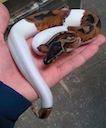» Site Navigation

1 members and 551 guests
Most users ever online was 47,180, 07-16-2025 at 05:30 PM.
» Today's Birthdays

» Stats

Members: 75,909
Threads: 249,113
Posts: 2,572,173
Top Poster: JLC (31,651)
|
-
Registered User


 Re: Wobble Gene Re: Wobble Gene
 Originally Posted by paulh

1. Is there a malfunction in a specific area of the brain that causes the wobble? Or a malfunction in the balance organs? Some other malfunction? Might microscopic examination of the brain/head turn up whatever causes the malfunction? How might covering the eyes or plugging the labial pits affect wobbling?
It's really, really hard to get permission to look at vertebrate brains in scientific research - even the 'unpopular' animals (e.g. rats, mice are less sympathetic to the public than bunnies) and even for research that has direct impacts on human disease treatment.
If you could get snake owners/breeders from all over to donate naturally deceased spider-gene-containing animals, you could do some autopsy comparisons, but my guess is that 'wobble' is a biochem or live tissue problem - brains the size of ball pythons don't typically have architectural defects without lethality. Furthermore, there is no degeneration of the 'wobble' (critters don't get worse), so whatever it is, it's stable within the individual.
The University of California at Berkeley has a preparatory lab that accepts donated animals of all kinds (really) for dissection by classes and lab techs for species descriptions, preservation, and comparative anatomy. They might need a small donation/grant/endowment to set up enough space and time to look at that many of a single species, but if you're really excited about it, you should contact them and see!
-
-
Registered User


Our lesser bee wobbled pretty bad when small, but now that she is growing i rarely see it anymore
1.0 lesser yellowbelly
1.0 banana
1.0 black pastel
0.1 lesserbee (Alice)
1.0 firefly (cranky Frankie)
0.1 fire (Dottie)
0.1 het clown
1.0 double het pied/clown (Stryker)
1.0 bearded dragon (Ziggy)
0.1 sulcata (Ellie)
1.0 mini schnauzer (Bailey)
1.0 b rainbow boa (Trip)
-
-
Registered User


Re: Wobble Gene
I know this thread is getting a bit old now so maybe a lot of people have stopped reading it but i returned to it and saw the comments about trying to fix it with brother to sister mattings.
I am just wondering if some of the genetic problems in snakes (and indeed many pets) is actually due to inbreeding. In some animals it is avoidable due to the size of the genetic pool but in the issue of ball pythons where all known morphs can often be traced to a single animal surely it is the mother to son, father to daughter, brother to sister matings that has put the defect into the animal in the first place ?
-
-
Re: Wobble Gene
 Originally Posted by Paul's Pieds

I know this thread is getting a bit old now so maybe a lot of people have stopped reading it but i returned to it and saw the comments about trying to fix it with brother to sister mattings.
I am just wondering if some of the genetic problems in snakes (and indeed many pets) is actually due to inbreeding. In some animals it is avoidable due to the size of the genetic pool but in the issue of ball pythons where all known morphs can often be traced to a single animal surely it is the mother to son, father to daughter, brother to sister matings that has put the defect into the animal in the first place ?
No, not with this example. Bear in mind that due the issues around any pairing from wobble genes, such pairings are very rare (the super spider and wobble gene to wobble gene combos are said to be lethal). Knowing this, breeding spider gene carrying siblings together or back to the parents almost never happens just on principle. With these pairings being very few and far between, I would say with certainty that inbreeding was not a cause of the wobble, nor does it contribute to its continuation.
Last edited by Daigga; 02-26-2015 at 06:00 PM.
-
-
Re: Wobble Gene
Many genetic problems in domestic animals are due to inbreeding. That is certainly true in dogs and mice.
I do not believe that the wobble in spider ball pythons is due to inbreeding. As spider bred to normal produces both spider and normal babies, the temptation has always been to breed a spider male to multiple normal females, for maximum return on investment. There was only one imported spider, so that first mating had to have been to one or more normals. And World of Ball Pythons gives 1999 for the first produced date. That is only 16 years ago. I do not know whether that imported royal is still alive, but its offspring could easily still be alive and breeding. Both outbreeding and inbreeding can produce train wrecks from a minimal wobble parent. But selective breeding would be required to produce lines with minimal wobble, and that requires inbreeding. Choosing two spiders for parents tells us that both have minimal wobble. If one parent is a normal sibling, there is no way to be sure whether or not it has the additional genes for minimal wobble. Such breeding might throw some light on the homozygous spider question, but that's a beneficial side effect to the project.
I do not know whether is possible to produce a totally wobble-free spider ball python. But nothing ventured, nothing gained.
Covering the eyes or the labial pits would eliminate information from those sense organs. If a part of the brain misinterprets such information and thus causes the wobble, then cutting off the information to that part of the brain could reduce or eliminate the wobble. I think it is interesting that everyone says the wobble is worst at feeding time, when eye and labial pit information is most depended on.
-
The Following User Says Thank You to paulh For This Useful Post:
 Posting Permissions
Posting Permissions
- You may not post new threads
- You may not post replies
- You may not post attachments
- You may not edit your posts
-
Forum Rules
|









 Reply With Quote
Reply With Quote